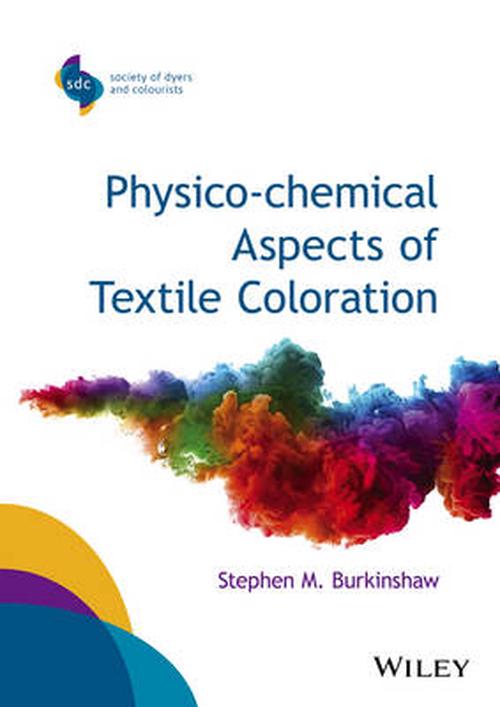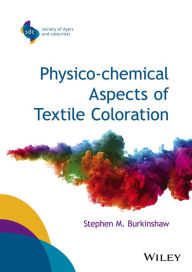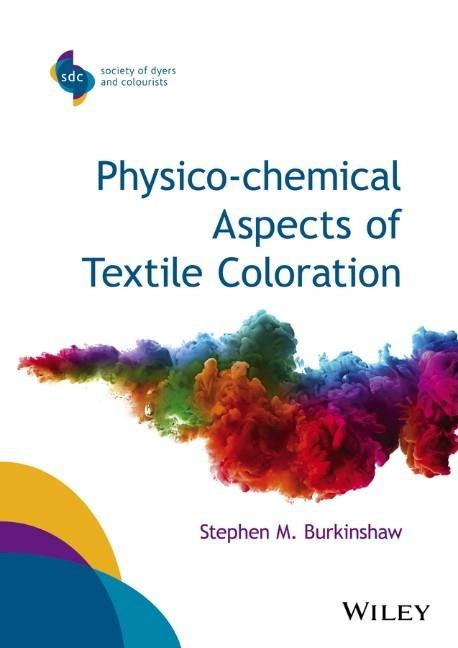
2016, ISBN: 1118725697
Gebundene Ausgabe
[EAN: 9781118725696], Neubuch, [PU: John Wiley & Sons Inc, New York], Hardcover. The production of textile materials comprises a very large and complex global industry that utilises a div… Mehr…
| AbeBooks.de CitiRetail, Stevenage, United Kingdom [9235530] [Rating: 4 (von 5)] NEW BOOK. Versandkosten: EUR 29.24 Details... |

2016, ISBN: 1118725697
Gebundene Ausgabe
[EAN: 9781118725696], Neubuch, [PU: John Wiley & Sons Inc, New York], Hardcover. The production of textile materials comprises a very large and complex global industry that utilises a div… Mehr…
| AbeBooks.de AussieBookSeller, Truganina, VIC, Australia [52402892] [Rating: 5 (von 5)] NEW BOOK. Versandkosten: EUR 34.29 Details... |

ISBN: 9781118725696
The production of textile materials comprises a very large and complex global industry that utilises a diverse range of fibre types and creates a variety of textile products. As the great… Mehr…
| BarnesandNoble.com new in stock. Versandkosten:zzgl. Versandkosten. Details... |

ISBN: 9781118725696
The production of textile materials comprises a very large and complex global industry that utilises a diverse range of fibre types and creates a variety of textile products. As the great… Mehr…
| BarnesandNoble.com new in stock. Versandkosten:zzgl. Versandkosten. Details... |

2016, ISBN: 1118725697
[EAN: 9781118725696], Neubuch, [SC: 0.0], [PU: John Wiley & Sons], SCIENCE CHEMISTRY PHYSICAL & THEORETICAL TECHNOLOGY ENGINEERING CHEMICAL BIOCHEMICAL CELLULOSE-, PAPIER- U. TEXTILCHEMIE… Mehr…
| ZVAB.com moluna, Greven, Germany [73551232] [Rating: 4 (von 5)] NEW BOOK. Versandkosten:Versandkostenfrei. (EUR 0.00) Details... |


2016, ISBN: 1118725697
Gebundene Ausgabe
[EAN: 9781118725696], Neubuch, [PU: John Wiley & Sons Inc, New York], Hardcover. The production of textile materials comprises a very large and complex global industry that utilises a div… Mehr…

2016, ISBN: 1118725697
Gebundene Ausgabe
[EAN: 9781118725696], Neubuch, [PU: John Wiley & Sons Inc, New York], Hardcover. The production of textile materials comprises a very large and complex global industry that utilises a div… Mehr…

ISBN: 9781118725696
The production of textile materials comprises a very large and complex global industry that utilises a diverse range of fibre types and creates a variety of textile products. As the great… Mehr…

ISBN: 9781118725696
The production of textile materials comprises a very large and complex global industry that utilises a diverse range of fibre types and creates a variety of textile products. As the great… Mehr…

2016, ISBN: 1118725697
[EAN: 9781118725696], Neubuch, [SC: 0.0], [PU: John Wiley & Sons], SCIENCE CHEMISTRY PHYSICAL & THEORETICAL TECHNOLOGY ENGINEERING CHEMICAL BIOCHEMICAL CELLULOSE-, PAPIER- U. TEXTILCHEMIE… Mehr…
Bibliographische Daten des bestpassenden Buches
| Autor: | |
| Titel: | |
| ISBN-Nummer: |
The production of textile materials comprises a very large and complex global industry that utilises a diverse range of fibre types and creates a variety of textile products. As the great majority of such products are coloured, predominantly using aqueous dyeing processes, the coloration of textiles is a large-scale global business in which complex procedures are used to apply different types of dye to the various types of textile material. The development of such dyeing processes is the result of substantial research activity, undertaken over many decades, into the physico-chemical aspects of dye adsorption and the establishment of ‘dyeing theory’, which seeks to describe the mechanism by which dyes interact with textile fibres.
Physico-Chemical Aspects of Textile Coloration provides a comprehensive treatment of the physical chemistry involved in the dyeing of the major types of natural, man-made and synthetic fibres with the principal types of dye. The book covers:
The up-to-date text is supported by a large number of tables, figures and illustrations as well as footnotes and widespread use of references to published work. The book is essential reading for students, teachers, researchers and professionals involved in textile colorat
Detailangaben zum Buch - Physico-chemical Aspects of Textile Coloration Stephen M. Burkinshaw Author
EAN (ISBN-13): 9781118725696
ISBN (ISBN-10): 1118725697
Gebundene Ausgabe
Taschenbuch
Erscheinungsjahr: 2016
Herausgeber: Wiley Core >2 >T
Buch in der Datenbank seit 2015-10-25T13:29:39+01:00 (Berlin)
Detailseite zuletzt geändert am 2024-04-11T08:11:01+02:00 (Berlin)
ISBN/EAN: 9781118725696
ISBN - alternative Schreibweisen:
1-118-72569-7, 978-1-118-72569-6
Alternative Schreibweisen und verwandte Suchbegriffe:
Titel des Buches: aspects the novel, textil, text textile
Daten vom Verlag:
Autor/in: Stephen M. Burkinshaw
Titel: SDC - Society of Dyers and Colourists; Physico-chemical Aspects of Textile Coloration
Verlag: Wiley; John Wiley & Sons
648 Seiten
Erscheinungsjahr: 2016-02-05
Gewicht: 1,672 kg
Sprache: Englisch
162,00 € (DE)
Not available (reason unspecified)
214mm x 297mm x 35mm
BB; Hardcover, Softcover / Chemie/Physikalische Chemie; Physikalische Chemie; Cellulose-, Papier- u. Textilchemie; Cellulose/Paper/Textile Chemistry; Chemie; Chemistry; Physical Chemistry; Physikalische Chemie; Textilchemie; Cellulose-, Papier- u. Textilchemie; Physikalische Chemie
Society of Dyers and Colourists xi Preface xiii 1 Fundamental Aspects of Textile Fibres 1 1.1 Textiles 1 1.1.1 Yarn 2 1.1.2 Fabric 4 1.1.3 Textile Markets 6 1.2 Textile Fibres 6 1.2.1 Textile Fibre Classification 7 1.2.2 Textile Usage 9 1.2.3 The History and Development of Textile Fibres 9 1.2.4 Textile Polymers 12 1.2.5 Textile Fibre Morphology and Fine Structure 16 1.3 General Physical and Mechanical Characteristics of Textile Fibres 27 1.3.1 Length 27 1.3.2 Fineness 27 1.3.3 Twist 32 1.3.4 Fibre Specific Surface Area, Sm or Sv 33 1.3.5 Cross-Sectional Shape 33 1.4 Properties of Textile Fibres 35 1.4.1 Mechanical Properties 35 1.4.2 Thermal Properties 37 1.4.3 Optical Properties 48 References 51 2 Dyes 65 Introduction 65 2.1 Dyes 65 2.1.1 Historical Aspects 66 2.1.2 Classification of Colorants 71 2.1.3 Colour and Constitution 75 2.1.4 Commercial Dye Forms 75 2.1.5 Commercial Dye Names 76 2.1.6 Global Dye Consumption 76 References 76 3 The Role of Water in Aqueous Dyeing 81 Introduction 81 3.1 Water Structure 82 3.2 Water Availability and Global Consumption 84 3.2.1 Water Footprint 85 3.3 Water Use in Dyeing 86 3.3.1 Water Used in Cotton Production 86 3.3.2 Water Used in Fibre Processing 87 3.3.3 Water Used in Dyeing 87 3.4 Water and Textile Fibres 91 3.4.1 Hydrophilicity and Hydrophobicity 93 3.4.2 Moisture Sorption 94 3.4.3 The Porous Nature of Fibres 103 3.4.4 Wetting and Wicking 105 3.4.5 Swelling 109 3.4.6 Water Plasticisation 110 3.5 Water and Dyes 116 3.5.1 Solvation 117 3.5.2 Dye Solubility 120 3.5.3 Dye Aggregation in Solution 123 3.5.4 Dye Aggregation in the Fibre 129 3.5.5 Aqueous Dye Dispersions 129 3.6 pH and pK 134 3.6.1 Water Ionisation (Ionic Product of Water) 134 3.6.2 The pH Scale 135 3.6.3 pKa and pKb 136 3.6.4 Buffer Systems and the Henderson-Hasselbalch Equation 136 References 137 4 Fundamentals of Dyeing 153 Introduction 153 4.1 Dye-Fibre Systems 154 4.2 Fundamental Principles of Dyeing 156 4.2.1 Dye-Fibre Substantivity 156 4.2.2 Driving Force for Dyeing 157 4.2.3 Dye Exhaustion 157 4.2.4 Rate of Dyeing 158 4.2.5 Depth of Shade 159 4.2.6 Liquor Ratio 159 4.2.7 Dye Fixation 160 4.2.8 Wash-Off 161 4.2.9 Fastness 162 4.2.10 Dyeing Auxiliaries 163 References 164 5 Dye-Fibre Interactions 167 Introduction 167 5.1 Intermolecular Interactions (or Forces) between Atoms and Molecules 167 5.1.1 Covalent Bonds 169 5.1.2 Ion-Ion Interactions (aka Charge-Charge, Coulomb, Electrostatic Interactions) 169 5.1.3 Ion-Dipole Interactions (aka Charge-Dipole, Monopole-Dipole) 169 5.1.4 Van der Waals Interactions (aka van der Waals Forces) 170 5.1.5 Hydrogen Bonds 172 5.1.6 Hydrophobic Effect and Hydrophobic Interactions 172 5.1.7 Total (Attractive and Repulsive) Intermolecular Potentials 173 5.1.8 Aromatic Interactions (aka pi-Interactions, pi-Effects) 173 5.2 Intermolecular Interactions (or Forces) between Macromolecules and Surfaces 176 5.2.1 Dispersion Interactions 176 5.2.2 Electrostatic Forces 178 5.3 Intermolecular Forces in the Context of Textile Fibres and Dyes 190 5.3.1 Intermolecular Forces in Textile Polymers 190 5.3.2 Intermolecular Forces between Dyes and Fibres 191 5.4 Solubility Parameter 192 5.4.1 Hildebrand Solubility Parameter 193 5.4.2 Hansen Solubility Parameters 193 5.4.3 Solubility Parameters and Dye-Fibre Substantivity 194 5.4.4 Carriers 194 5.5 Fibre Modification to Enhance Dye-Fibre Substantivity 195 5.5.1 Mercerisation 195 5.5.2 Plasma 197 5.5.3 Pre-treatment with Cationic Compounds 199 5.5.4 Nucleophilic Dyes on Modified Substrates 200 References 200 6 Dyeing Theory 209 Introduction 209 6.1 Background 210 6.2 Dyeing Systems at Equilibrium (the Thermodynamics of Dyeing) 211 6.2.1 Adsorption 213 6.2.2 Standard Affinity, Standard Heat and Standard Entropy of Dyeing 216 6.3 Kinetics of Dyeing 221 6.3.1 Diffusion 222 6.3.2 Steady-State and Non-Steady-State Diffusion 223 6.3.3 Fick's Laws of Diffusion 223 6.3.4 Experimental Methods for Determining Diffusion Coefficient 224 6.3.5 Approximate Solutions to Diffusion Equations 228 6.3.6 Characterisation of the Rate of Dyeing 228 6.3.7 Apparent Diffusion Coefficient 229 6.3.8 Boundary Layers in Diffusion 231 6.3.9 Effect of Temperature on Dye Diffusion 233 6.3.10 Influence of Fibre Structure on Diffusion 235 6.3.11 Influence of Dye Structure on Diffusion 237 References 241 7 Cellulosic Fibres 249 Introduction 249 7.1 Cotton 249 7.2 Viscose Fibres 250 7.2.1 Skin-Core Structure 251 7.3 Lyocell Fibres 252 7.4 CA and CTA Fibres 254 7.5 Cellulose Chemistry and Molecular Structure 256 7.5.1 Crystal Forms 257 7.6 Cellulosic Fibre Fine Structure 260 7.7 Hydroxyl Groups in Cellulosic Fibres 261 7.7.1 Accessibility 261 7.8 Water/Cellulose Interactions 263 7.8.1 Moisture Sorption 263 7.8.2 Free and Bound Water 265 7.8.3 Pore Structure 266 7.8.4 Swelling 267 7.8.5 Bleaching of Cotton and Other Cellulosic Fibres 270 7.8.6 Plasticisation 270 7.9 Dye Classes Used on Cellulosic Fibres 272 7.10 The Role of Electrolyte in Cellulosic Fibre Dyeing 273 7.10.1 Nature of the Charged Cellulosic Fibre 274 7.10.2 Zeta Potential of Cellulosic Fibres 274 7.10.3 The Amount of Electrolyte Required to 'Neutralise' the Negative Surface Charge 279 7.10.4 Effect of Electrolyte on Dye Aggregation and Dye Solubility 280 7.11 Direct Dyes 281 7.11.1 Classification of Direct Dyes 282 7.11.2 Thermodynamics of Dyeing 283 7.11.3 Kinetics of Dyeing 297 7.11.4 Aftertreatment 301 7.12 Sulphur Dyes 302 7.12.1 Fundamentals of the Chemistry and Application of Sulphur Dyes for Cellulosic Fibres 303 7.12.2 Dye Application 304 7.13 Vat Dyes 305 7.13.1 Fundamentals of the Chemistry and Application of Vat Dyes for Cellulosic Fibres 306 7.13.2 Reduction 308 7.13.3 Adsorption of the Leuco Derivative (Dyeing) 312 7.13.4 Kinetics of Leuco Vat Application 317 7.13.5 Oxidation of the Adsorbed Dye 318 7.13.6 Soaping 319 7.14 Reactive Dyes 319 7.14.1 Fundamentals of the Chemistry and Application of Reactive Dyes for Cellulosic Fibres 320 7.14.2 Mechanism of Dyeing 325 7.14.3 Wash-Off 334 7.14.4 Aftertreatment 337 7.15 Azoic Colorants 337 7.15.1 Naphtholation 338 7.15.2 Development 338 7.15.3 Wash-Off 339 7.16 Disperse Dyes 340 References 340 8 Polyester Fibres 359 Introduction 359 8.1 PES Fibres 359 8.1.1 Fibre Production and Properties 360 8.1.2 Physical Structure 361 8.1.3 Oligomers 363 8.1.4 Sheath/Core Structure 365 8.1.5 Transitions (Relaxations) 365 8.1.6 PES/Water Interactions 366 8.1.7 Dyeing of PES Fibres 367 8.2 PLA Fibres 403 8.2.1 Polymer Synthesis 404 8.2.2 PLA Biodegradability 405 8.2.3 Fibres 405 References 413 9 Polyamide Fibres 427 Introduction 427 9.1 Aliphatic Polyamide Fibres 427 9.1.1 Nomenclature and Types of Polyamides 427 9.1.2 PA 6 and PA 66 429 9.1.3 Physical Structure 430 9.2 Dyeing of Aliphatic Polyamides 445 9.2.1 Effect of Physical Processing on Dyeing 446 9.2.2 Barré Effects 446 9.2.3 Levelling Agents 447 9.3 Acid Dyes 447 9.3.1 Non-metallised Acid Dyes 448 9.3.2 Pre-metallised Acid Dyes (Aka Metal Complex Dyes) 464 9.3.3 Aftertreatment 465 9.4 Disperse Dyes 467 9.5 Mordant Dyes 467 9.6 Direct Dyes 468 9.7 Reactive Dyes 468 9.7.1 Anionic Reactive Dyes 469 9.7.2 Disperse Reactive Dyes 470 9.8 Sulphur Dyes 470 9.9 Vat Dyes 471 9.10 Azoic Colorants 471 9.11 Microfibres 471 9.12 Semi-Aromatic Polyamides 473 9.13 Aromatic Polyamides 474 9.13.1 Fine Structure 475 9.13.2 Water/Aramid Interactions 476 9.13.3 Dyeing of Aromatic Polyamide Fibres 478 References 479 10 Wool Fibres 491 Introduction 491 10.1 Wool Chemistry and Molecular Structure 491 10.1.1 Proteins and Amino Acids 491 10.1.2 Fibre Morphology 494 10.1.3 Fine Structure 496 10.1.4 Water/Wool Interactions 497 10.1.5 Swelling and Heat of Sorption 498 10.1.6 Sorption of Acids and Alkalis 499 10.1.7 Water Plasticisation 499 10.1.8 Effect of Physical and Chemical Properties on Dyeing 500 10.2 Dyes for Wool 500 10.3 Non-metallised Acid Dyes 501 10.3.1 Thermodynamics of Dyeing 501 10.3.2 Effect of Electrolyte on Dye Adsorption 509 10.3.3 Affinities of Acids and Dye Anions 511 10.3.4 Kinetics of Dyeing 513 10.4 Pre-metallised Acid Dyes (Aka Metal Complex Dyes) 516 10.4.1 1 : 1 Metal Complex Dyes 517 10.4.2 1 : 2 Metal Complex Dyes 518 10.5 Mordant Dyes 519 10.5.1 Mechanism of Chroming 520 10.6 Reactive Dyes 521 10.6.1 Historical Aspects 521 10.6.2 Chemistry and Application of Reactive Dyes 521 10.6.3 Levelling Agents 522 References 524 11 Acrylic (polyacrylonitrile) Fibres 531 Introduction 531 11.1 Fibre Production and Properties 531 11.2 Physical Structure 532 11.2.1 Crystallinity or Pseudocrystallinity 533 11.2.2 Transitions (Relaxations) 533 11.2.3 Theories of Fine Structure 533 11.3 PAN/Water Interactions 535 11.3.1 Water Plasticisation 535 11.4 Dyes for PAN Fibres 536 11.5 Basic Dyes 536 11.5.1 Historical Aspects 536 11.5.2 General Characteristics of Basic Dyes 537 11.5.3 Thermodynamics of Dyeing 538 11.5.4 Kinetics of Dyeing 543 11.5.5 Effect of Electrolytes on Dyeing 545 11.5.6 Effect of pH on Dyeing 547 11.5.7 Effect of Temperature on Dyeing 548 11.5.8 Retarding Agents 550 11.5.9 Dyes in Admixture 550 11.5.10 Carriers 551 11.6 Disperse Dyes 551 11.6.1 Thermodynamics of Dyeing 552 11.6.2 Kinetics of Dyeing 552 References 553 12 Silk Fibres 559 12.1 Fibre Morphology 559 12.2 Silk Chemistry and Molecular Structure 559 12.3 Fine Structure 560 12.4 Silk/Water Interactions 564 12.4.1 Water Plasticisation 564 12.5 Dyes for Silk 565 12.5.1 Acid Dyes 566 12.5.2 Reactive Dyes 567 References 568 13 Non-aqueous Dyeing 571 Introduction 571 13.1 Dyeing from Air (Vapour-Phase Dyeing; Thermofixation) 571 13.1.1 General Introduction 571 13.1.2 Thermodynamics of Dyeing 571 13.1.3 Kinetics of Dyeing 573 13.2 Dyeing from Supercritical Carbon Dioxide 575 13.2.1 General Introduction 575 13.2.2 Properties of Supercritical CO2 Fluids 575 13.2.3 Solubility of Dyes in Supercritical CO2 577 13.2.4 Effect of Supercritical CO2 on Fibres 579 13.2.5 Dyeing from Supercritical CO2 582 13.3 Dyeing from Liquid (Non-aqueous) Solvents 592 13.3.1 PER Dyeing 592 13.3.2 Solvent-Assisted Dyeing 594 References 594 Colorants Index 601 Subject Index 605Weitere, andere Bücher, die diesem Buch sehr ähnlich sein könnten:
Neuestes ähnliches Buch:
9781118725665 Physico-chemical Aspects of Textile Coloration (Burkinshaw, Stephen M.)
< zum Archiv...

